Key Points:
- These two species of snake differ wildly in habitat, behavior, and size.
- One similarity the rattlesnake and king cobra share is the ability to climb trees.
- The king cobra is the more venomous of the two.
While a king cobra and a rattlesnake are unlikely to interact given their geographic locations, are there ways in which these snakes differ? Given that king cobras belong to a totally different family compared to rattlesnakes, you can no doubt imagine their differences. But what might those be, and how can you learn how to distinguish these two snakes from one another?
In this article, we will address the many differences between a king cobra and a rattlesnake, including their habitats and dietary preferences. We’ll address their behavioral differences and appearances as well so that you can learn everything there is to know about these snakes. Let’s get started!
Comparing King Cobra vs. Rattlesnake

| King Cobra | Rattlesnake | |
| Size | 12-18 feet long | 1-8 feet long |
| Appearance | Smooth scales found in black, brown, green, and yellow shades; has a fanlike head with chevron patterns on its back. | Coloring varies based on habitat; triangular head and vertical pupils; raised scales and diamond patterned body. Has a namesake rattle on the end of its tail. |
| Location and Habitat | Asia; lives in trees and warm, humid climates such as forests and marshes | North, Central, and South America; mountains, deserts, grassy areas |
| Behavior | Fans its hood out and rises up when threatened; often makes eye contact with its predator or prey. Considered incredibly venomous. | Extremely potent bite for humans, but prefers to be left alone; rattles its tail to ward off predators. Changes the times of day it hunts based on the season. |
| Diet | Lizards, birds, and other snakes | Rats, mice, lizards, rats, and frogs |
Key Differences Between King Cobra vs. Rattlesnake
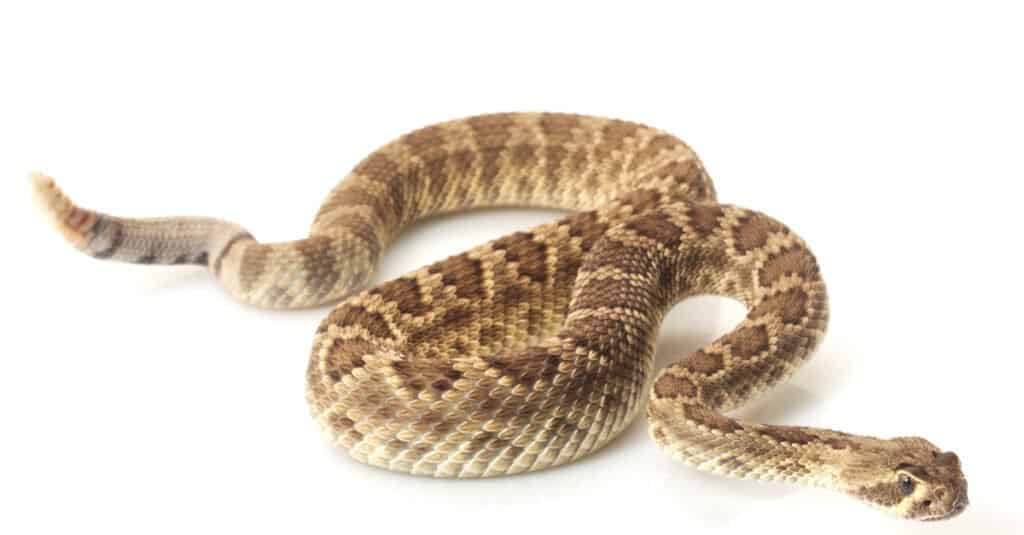
A king cobra is only found in Asia, while rattlesnakes are found throughout the Americas.
©fivespots/Shutterstock.com
There are many key differences between a king cobra vs rattlesnake. When comparing their sizes, king cobras grow much longer than rattlesnakes despite rattlesnakes having thicker bodies. A king cobra is only found in Asia, while rattlesnakes are found throughout the Americas. Finally, rattlesnakes have a distinct rattle on the ends of their tails while king cobras have a hood or fan surrounding their head.
Let’s discuss all of these differences in more detail now.
Size and Weight
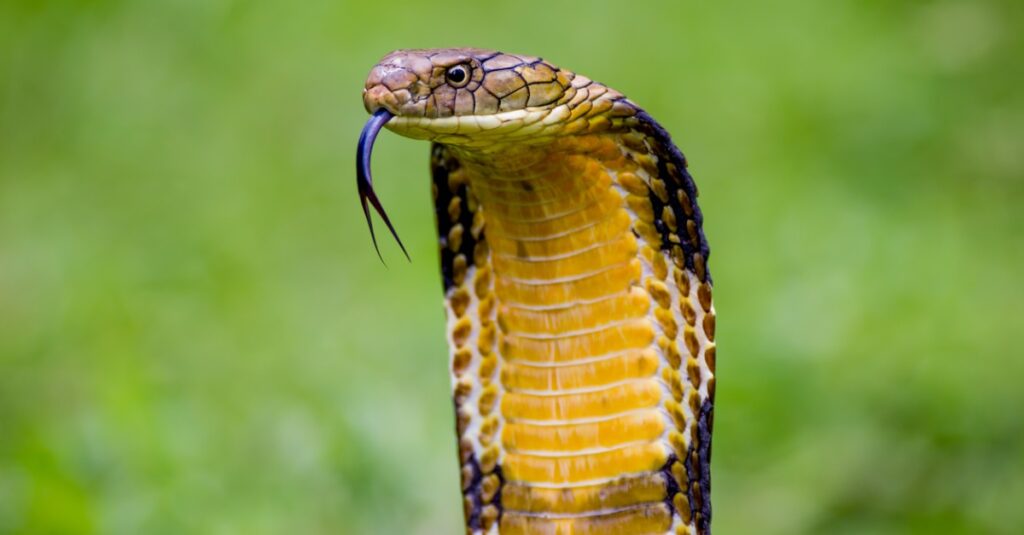
Rattlesnakes have a distinct rattle on the ends of their tails while king cobras have a hood or fan surrounding their head.
©iStock.com/takeo1775
King cobras are considered one of the longest venomous snakes in the world, especially when compared to rattlesnakes. For example, depending on the species, rattlesnakes grow an average of 1-8 feet long while king cobras grow anywhere from 12-18 feet long. This is a huge difference, as king cobras are much larger when compared to rattlesnakes. This also means that king cobras weigh more than rattlesnakes do.
Location and Habitat Preferences

Rattlesnakes grow an average of 1-8 feet long while king cobras grow anywhere from 12-18 feet long.
©Frode Jacobsen/Shutterstock.com
Rattlesnakes and king cobras do not exist in the same environments, given their geographical locations. To understand fully what this means, it is important to note that king cobras are only found in Asia while rattlesnakes are found in North, Central, and South America. This means that the paths of these two snakes will never cross!
Their habitat preferences differ as well, given their completely opposite geographical locations. For example, rattlesnakes enjoy arid desert and dry forest climates, while king cobras thrive in warm and humid climates. You can find king cobras in rainforests and marshy areas, while rattlesnakes prefer to avoid aquatic environments in exchange for dry rocks and grasslands.
Appearance
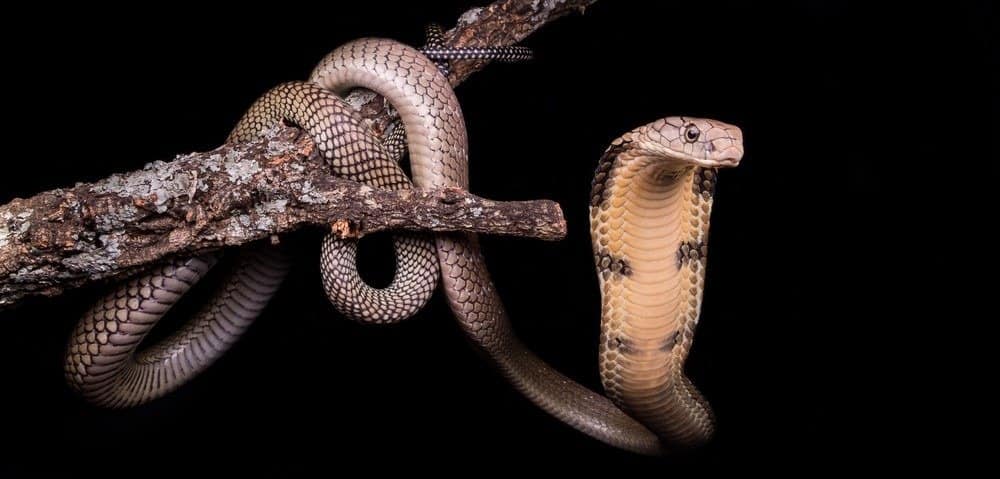
King cobras can grow over twice as long as a rattlesnake.
©Sibons photography/Shutterstock.com
The physical differences between a king cobra and a rattlesnake are obvious from just a glance. While rattlesnakes have a signature rattle on the end of their tail, king cobras do not have this feature. In fact, king cobras have a distinct hood or fan surrounding their head, while rattlesnakes do not share this.
The markings and colorations of king cobras differ from rattlesnakes as well. Rattlesnakes have a distinct diamond pattern along their backs, and king cobras have chevron patterns on their bodies. The body of a king cobra may also be striped in a variety of colors, such as black, green, and brown. Rattlesnakes come in many colors, depending on their environment, including brown, tan, peach, and black.
Behavior
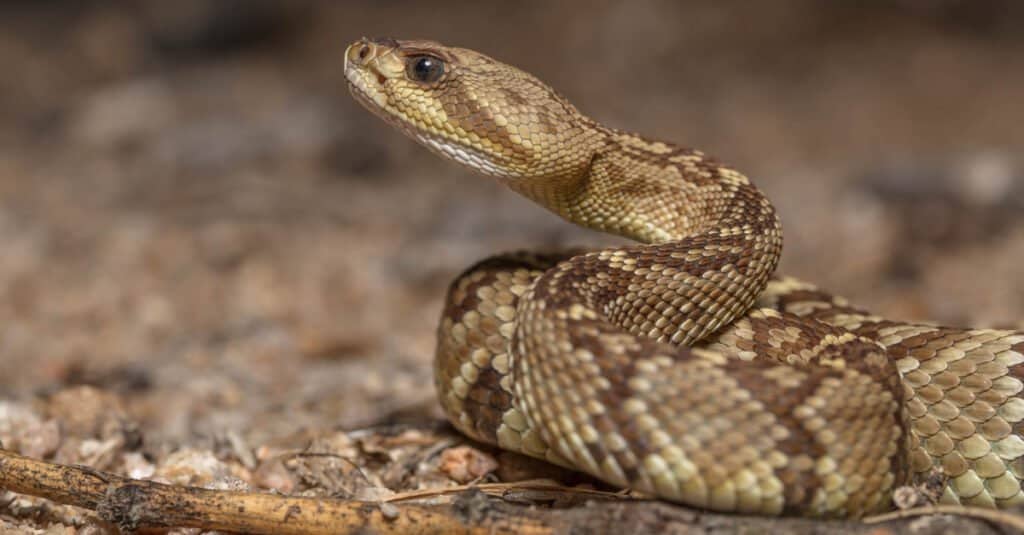
While rattlesnakes have a signature rattle on the end of their tail, king cobras do not have this feature.
©Alexander Wong/Shutterstock.com
While both king cobras and rattlesnakes prefer to be left alone, there are some key behavioral differences between these snakes. For example, rattlesnakes coil up and rattle their tails when threatened, while cobras rise up and expand their hooded heads when threatened. King cobras are also capable of maintaining eye contact and following their predators or threats, while rattlesnakes do not behave in this way.
Both rattlesnakes and king cobras climb trees, though king cobras enjoy hunting and living in trees often. Rattlesnakes prefer to be on land, and their hunting styles illustrate this. Additionally, while the venom in a king cobra is technically weaker than that of a rattlesnake, king cobras inject enough venom to kill multiple people when threatened. This makes king cobras more dangerous than rattlesnakes, but both snakes prefer to avoid conflict.
Diet and Hunting Style

King cobras are the longest venomous snake in the world and can reach 18 feet long.
©RealityImages/Shutterstock.com
Given their extremely different geographical locations and sizes, you may have already guessed that king cobras and rattlesnakes differ in their diet and hunting styles. King cobras are called king cobras because one of their favorite meals is other snakes. Rattlesnakes eat rats, mice, lizards, rats, and frogs, while king cobras eat birds, lizards, and other snakes.
This is an important distinction between them, as king cobras spend much of their time in trees. This makes birds a huge part of their diet, while rattlesnakes are more likely to eat rodents. King cobras also have better eyesight compared to rattlesnakes, making hunting a breeze comparatively.
And when it comes to hunting prowess and deadliness, there’s another big difference between these two snakes. The venom of king cobras is much more dangerous. Neither snake injects venom with 100% of its bites. But the king cobra’s venom is more potent and administered in higher quantities than even the eastern diamondback rattlesnake, one of the deadliest rattlesnakes.
Bonus: What U.S. Rattlesnake Species Are the Most Dangerous?
Rattlesnakes are among the most deadly venomous snakes in the U.S. But their bites vary in toxicity, so it’s a good idea to be educated on what rattlesnakes are the most dangerous.
Mojave Green Rattlesnake

Some experts classify the Mojave green rattlesnake as the deadliest rattlesnake species in the United States.
©iStock.com/Shoemcfly
Many experts classify the Mojave green rattlesnake, native to the Southwestern U.S. as well as Mexico, as the deadliest rattlesnake species on Earth. Its venom, which can be either hemotoxic or neurotoxic, can cause symptoms like vision impairment, difficulty swallowing and breathing, muscle weakness, severe body pain, convulsions, and death by cardiac arrest or respiratory failure if left untreated.
Eastern Diamondback Rattlesnake

The Eastern diamondback rattlesnake is responsible for the most deaths in the U.S. from snake bites.
©Chase D’animulls/Shutterstock.com
This rattler, found in the Eastern United States, is another contender for the deadliest rattlesnake in the United States. It’s also one of the largest snakes in the U.S., growing to a max length of 8.5 feet and max weight of 34 pounds. Its bite contains hemotoxic venom, capable of killing red blood cells and causing tissue damage. Another problem lies in the fact it can deliver 400-700 mg of venom in its bite, compared to 200-300 mg in the western diamondback rattlesnake, so its venom can lead to death. It’s believed that the Eastern diamondback rattlesnake is responsible for the most deaths by snakebite in the U.S.
Western Diamondback Rattlesnake
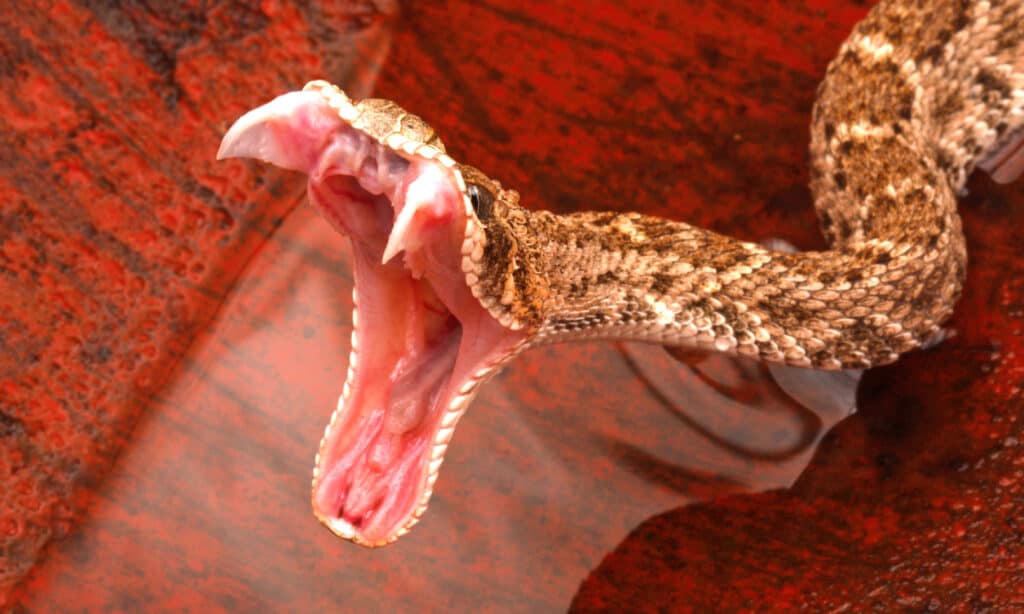
The venom from a Western diamondback rattlesnake is hemotoxic, attacking red blood cells and causing tissue damage to bite victims.
©iStock.com/johnaudrey
Close on the heels of the Eastern variety is the Western diamondback rattlesnake, native to the U.S. Southwest and northern Mexico. Its venom is hemotoxic, killing cells and tissue, causing blood clotting (or preventing clotting) that can result in massive internal bleeding, and causing possible cardiovascular failure. Some experts think this type of rattlesnake actually outranks the Eastern diamondback in terms of overall deaths to humans.
Other deadly U.S. rattlesnake species include:
- Timber Rattlesnake
- Massasauga Rattlesnake
- Southern Pacific Rattlesnake
- Banded Rock Rattlesnake
- Desert Massasauga Rattlesnake
The photo featured at the top of this post is ©
Discover the "Monster" Snake 5X Bigger than an Anaconda
Every day A-Z Animals sends out some of the most incredible facts in the world from our free newsletter. Want to discover the 10 most beautiful snakes in the world, a "snake island" where you're never more than 3 feet from danger, or a "monster" snake 5X larger than an anaconda? Then sign up right now and you'll start receiving our daily newsletter absolutely free.
Thank you for reading! Have some feedback for us? Contact the AZ Animals editorial team.






